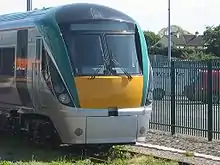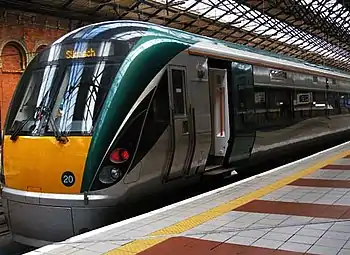IE 22000 Class
The 22000 Class "InterCity Railcar" is a diesel multiple unit in service with Iarnród Éireann in Ireland.
| Iarnród Éireann 22000 Class | |
|---|---|
 22054 at Drogheda MacBride | |
| In service | 19 December 2007 – present |
| Manufacturer | Hyundai Rotem (Trainsets) Tokyu Car Corporation (Bogies) |
| Family name | ICR |
| Replaced | 071 Class 121 Class 141 Class 181 Class Mark 2 Mark 3 |
| Constructed | 2007 – 2011, 2019 - |
| Number built | 63 trainsets |
| Formation | 3, 4 and 5 car trainsets |
| Fleet numbers | 22001 – 22063 |
| Capacity | 190 seated (3-car) 262 seated (4-car) 304 seated (5-car) |
| Operator(s) | InterCity Commuter |
| Depot(s) | Drogheda Depot Laois Traincare Depot |
| Specifications | |
| Train length | 70 m (230 ft) (3-car set) 93 m (305 ft) (4-car set) 117 m (384 ft) (5-car set) |
| Width | 2.84 m (9.3 ft) |
| Height | 4 m (13 ft) |
| Maximum speed | 160 km/h (99 mph) |
| Weight | 63 tonne per car |
| Prime mover(s) | MTU 6H 1800 R83 |
| Transmission | Voith T 312 R [1] |
| Track gauge | 1,600 mm (5 ft 3 in) See Rail gauge in Ireland |
They are the first IÉ DMUs built specifically for InterCity routes, although they can also work on some Commuter routes. They are designed to operate at a maximum speed of 160 km/h (100 mph).
History
In 2005, the Irish Government announced the €34 billion Transport 21 proposal for significant improvements to transport infrastructure, with major emphasis on the railway network. As part of this, large-scale replacement of rolling stock was planned, then made up entirely of locomotive-hauled coaching stock, the most based on the British Rail Mark 2 and Mark 3. IÉ ordered 120 replacement vehicles: in a major departure, the new trains would be 3 and 6 car DMUs rather than locomotive-hauled carriages. This order was extended to 150 vehicles in 2005, to 183 vehicles in 2007 and to 234 vehicles in December 2008.[2]
41 additional centre cars were ordered in 2019 for delivery from 2021.[3] No new driving cars would be ordered but as many services operate with two units joined currently it would be possible to reconfigure and release more units.
Deliveries
Supplied by Mitsui of Japan for approximately €400 million, the fleet was built by a partnership between Rotem of South Korea and Tokyu Car Corporation of Japan, who supplied the bogies. The first sets were delivered in March 2007, while the final sets were delivered in April 2012.
In March 2007, a €79 million order was placed for a further 33 vehicles to be used primarily on the outer Dublin commuter network. This was added to with an additional 51 Commuter vehicles in December 2008. As of 2015, there are 63 sets: 28 3-car sets, 25 4-car sets and 10 5-car sets, in three different layouts.
Two of the 3-car sets, 22010 and 22011, were delivered in July 2007 with corrosion damage received in transit from South Korea. IÉ did not accept delivery and stored the sets until October 2008 when they were returned to Rotem for repair, with a revised delivery date of early 2009.[4] It was later determined that it was uneconomic to repair them, so Rotem added two additional units to the last order at no additional cost to IÉ.[5]
Operations

The 22000 class was primarily ordered for InterCity routes except the Dublin-Belfast services operated by Enterprise and the Dublin-Cork service, for which IÉ purchased 67 locomotive-hauled coaches in 2006, but they have also been used on off-peak Dublin-Cork services since November 2009. 22000 units have now replaced coaching stock on services from Dublin to Galway, Westport, Limerick, Waterford and Tralee, and 2800 Class and 29000 Class DMUs to Sligo and Rosslare Europort.
The expansion of the Dublin commuter belt led IÉ to need dedicated long distance Commuter trains, and so purchased additional units for use on services to destinations such as Portlaoise, Carlow, Athlone, Dundalk, Kildare, and Longford; as well as Mallow in the Cork commuter belt.[2]
Plans by Enterprise to improve its services included the potential of purchasing DMUs to replace its locomotive-hauled coaching stock. Among the options under consideration was the purchase of further 22000 Class units.[6]
NI Railways was offered a variant of the 22000 Class to meet its "New Trains Two" requirement, before ultimately choosing a design similar to its existing Class 3000 unit.[7] The train was sometimes seen on the Dublin to Belfast railway line, on out-of-service transfer to Drogheda train service depot.
Unit types
As delivered, the first 30 units were of three cars, for use on InterCity routes, as were ten of the 15 6-car units. The remaining five 6-car sets and the 17 3-car sets ordered in 2008 were configured for long-distance Commuter services from Dublin. Combinations of two 3-car sets, three 3-car sets, two 4-car sets, a 3-car set + a 4-car set and two 5-car sets are possible. In case of emergency, they can operate in formations of up to 18 cars.
.jpg.webp)

- A1 22131–40: Driving car, catering, wheelchair accessible WC, one wheelchair space, 36 1st class seats
- A2 22207–30,41–63: Driving car, standard WC, 66 seats
- A22 22201–06: A2 car with NIR TPWS/AWS & radio system
- A3 22307–63: Driving car, wheelchair accessible WC, two wheelchair spaces, bicycle storage, 54 seats
- A33 22301–06: A3 car with NIR signal & radio system & parcels/bike space
- B 22401–63, 631–45, 731–45: Intermediate car, standard WC, 72 seats
- B1 22531–45: B car with sanding system
- 3-car sets: A2/A22 - B - A3/A33
- 4-car sets: A1/A2 - B - B/B1 - A3
- 5-car sets: A1/A22 - B - B1 - B - A3/A33
In 2013, IÉ announced plans to reform the 22000 class units from 3 and 6-car sets into 3 and 4-car units, to obtain better flexibility from them in regards to passenger numbers per train. However, it soon became apparent that replacing 6-car units with 4-car ones would lead to overcrowding, which caused IÉ to subsequently alter the proposal into sets of 3, 4 and 5-car lengths.[8] The 20 cars taken off the original 6-car sets 22031–45 and inserted in the original 3-car sets 22011–30 got additional numbers 22811–30 but also kept the original number 22531–540,641,741,642,742,643,743,644,744,645,745.
Fuel economy
There have been attempts to improve the fuel economy of the 22000 Class. In 2008 the class were modified to shut down the engines after a period of inactivity if the drivers cab key was off,[4] and in 2018 it was announced one three car unit was to trial a ZF transmission to replace the original Voith and it was hoped this might yield 19% fuel savings in some conditions.[9]
An additional nine cars are to be fitted with a diesel-battery hybrid MTU/Rolls Royce power pack as a trial,[10] with route-dependent fuel savings of up to 33% [11]
Future
In 2018, it was announced that Iarnród Éireann were seeking to procure a further 41 new 22000 Class vehicles, encompassing three additional units plus a number of intermediate trailers intended to lengthen some of the existing fleet. The ultimate aim is to return the fleet to a mix of three and six-car sets.[12]
An order for 41 intermediate ("type B") cars, which would release additional units by reconfiguration of existing pairs, was confirmed in October 2019 [13]
All units are undergoing an in-service interior overhaul, replacing the original cloth seats with leather and adding USB power sockets at each seating bay amongst other changes intended to reduce ongoing maintenance and cleaning costs [14]
Fleet details
| Class | Number | Year Built |
Built as |
Since 2014 |
Unit Numbers |
Routes Operated |
Notes | |
|---|---|---|---|---|---|---|---|---|
| 22000 | 10 | 2007–2009 2011 |
3-car | 3-car | 22001–22006 | InterCity & Commuter | Fitted with TPWS and AWS for use on NIR. 22001 fitted with in-cab signalling. | |
| 22007–22010 | 22010 returned to manufacturer and replaced with identically numbered unit | |||||||
| 18 | 2011 | 22046–22063 | ||||||
| 20 | 2007–2009 | 4-car | 22011–22030 | 22011 returned to manufacturer and replaced with identically numbered unit | ||||
| 22000 (HC) | 5 | 2007–2009 | 6-car | 22041–22045 | InterCity & Commuter | High Capacity | ||
| 22000 (P) | 10 | 2008 | 5-car | 22031–22040 | InterCity Enterprise |
Premier Class | ||
| 22036–22039 | Fitted with TPWS and AWS for use on NIR | |||||||
Features
- Engine: MTU 6H 1800 R83, 12.8 L, 6 cylinder, 483 bhp gross,[15] 386 bhp (288 kW) traction per car.
- Transmission: Voith T 312 R[16]
- Top speed: 160 km/h (100 mph)
- Body: high quality stainless steel with some corrosion-resistant carbon steel components [16]
- Automatic PA and information display systems (Supplier: SA Viewcom)
- Fully air-conditioned (Supplier: Toshiba)
- Saloon, external view of doors and front-facing CCTV camera and recording system (Supplier: Verint)
- Catering facilities (some trains have buffet bars)
- Individual base seating
- Fire safety to BS 6853 Cat 1B, automatic fire extinguishing system for engines & fuel tanks
- All sets have Irish standard CAWS signaling systems and train radio.
- 3-car sets 22001–22006, as well as 5-car sets 22036–22039 have TPWS/AWS for operation on Northern Ireland Railways.
Routes
InterCity services

- Dublin to Galway
- Dublin to Westport
- Dublin to Limerick
- Dublin to Tralee
- Dublin to Waterford
- Dublin to Portlaoise
- Dublin to Cork (off-peak)
- Cork to Tralee
- Waterford to Limerick Junction
- Limerick to Limerick Junction
- Dublin to Sligo
- Dublin to Rosslare Europort
- Dublin to Belfast (occasionally)
Commuter services
- Dublin to Newbridge/Kildare
- Dublin to Portlaoise
- Dublin to Maynooth/Longford
- Dublin to Drogheda/Dundalk
- Dublin to M3 Parkway
- Dublin to Gorey / Wexford
- Mallow to Tralee
- Maynooth/Drogheda to Bray
- Newbridge/Hazelhatch to Grand Canal Dock
See also
- Steam Locomotives of Ireland
- Diesel Locomotives of Ireland
- Multiple Units of Ireland
References
- Irish Railway Record Society
- Rail, Irish. "Fleet Investment". Irish Rail.
- https://www.railwaygazette.com/traction-and-rolling-stock/iarnrod-eireann-orders-dmu-cars-to-increase-commuter-capacity/54951.article
- "IRRS News 167". Irish Railway Record Society. 29 December 2008. Diesel Railcars. Archived from the original on 15 December 2018. Retrieved 11 February 2019.
- 22000 Class - IRRS 170
- NIR News 157 Archived 2012-02-08 at the Wayback Machine - IRRS
- Flanagan, Colm (2010). "Optimism in Northern Ireland". Modern Railways. 67 (737): 60–64.
- "Diesel Railcars". IRRS. Irish Railway Record Society. February 2014. Retrieved 14 August 2014.
- "Irish DMU transmission replacement expected to save fuel". Railway Gazette. 20 June 2018. Archived from the original on 23 June 2018. Retrieved 11 February 2019.
- https://www.railway-technology.com/news/irish-rail-and-porterbrook-order-rolls-royces-mtu-hybrid-powerpacks/
- https://www.rolls-royce.com/media/press-releases/2018/19-09-2018-rr-and-irish-rail-bring-mtu-hybrid-drives-to-the-emerald-isle.aspx
- Pritchard, Robert (February 2019). "Current and Future Development on Irish Rail". Today's Railways. Platform 5.
- https://www.newstalk.com/news/dublin-get-bigger-rail-capacity-new-scheme-919827
- https://www.therailwayhub.co.uk/6133/first-refurbished-ic-railcar-set-brought-into-service-by-irish-rail
- "MTU engine spec".
- IRRS Article
External links
| Wikimedia Commons has media related to IE 22000 Class. |